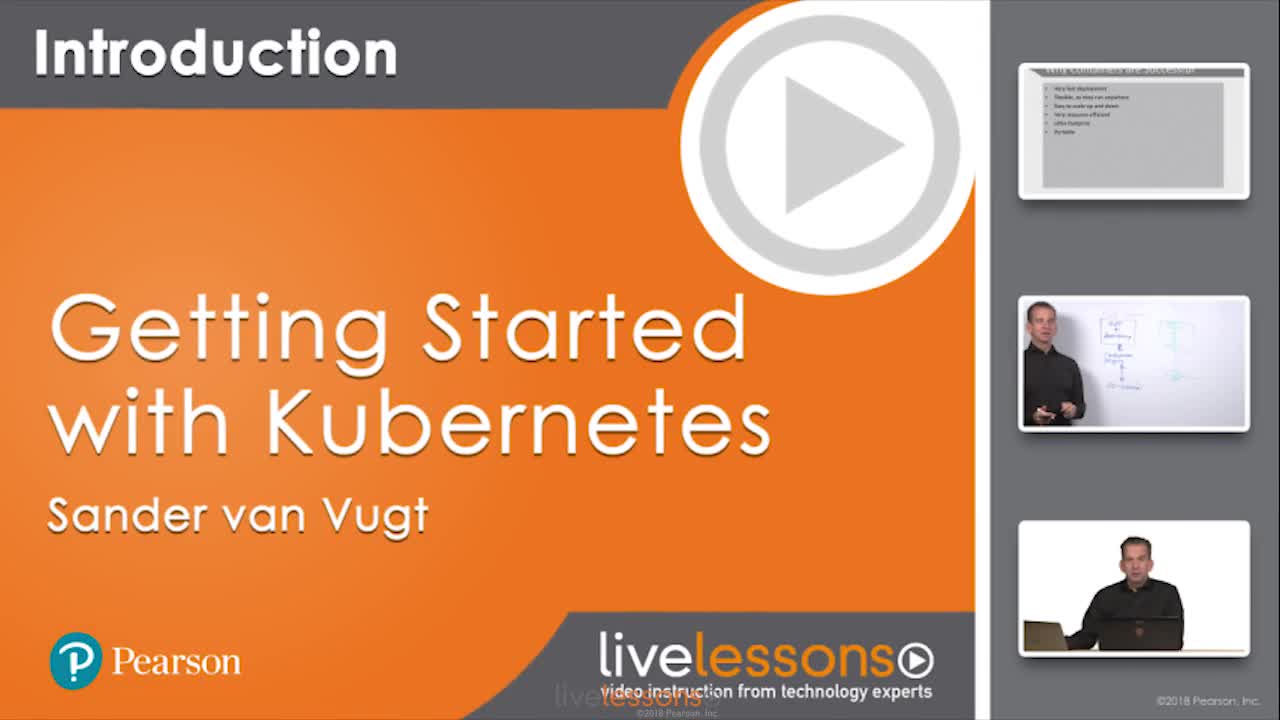Getting Started with Kubernetes LiveLessons
- By Sander van Vugt
- Published Jun 7, 2018 by Addison-Wesley Professional. Part of the LiveLessons series.
Online Video
- Sorry, this book is no longer in print.
- About this video
Video accessible from your Account page after purchase.
Register your product to gain access to bonus material or receive a coupon.
Description
- Copyright 2018
- Edition: 1st
- Online Video
- ISBN-10: 0-13-523781-5
- ISBN-13: 978-0-13-523781-6
6+ Hours of Video Instruction
More than six and a half hours of video instruction, including demos and labs, providing detailed explanations for leveraging Kubernetes as a tool for container orchestration and automation, including how to use it with Docker, pods, labels, volumes, as well as architectures and deployments.
Containers are taking over the traditional IT Environment to bring new software to users. Kubernetes was developed as an independent solution to manage and orchestrate containers in the corporate data center. As the source code has been donated to the Cloud Native Computing Foundation, Kubernetes has rapidly become the standard for container orchestration. It can be used within the premises of a corporate data center, but also integrated in all of the leading public cloud offerings.
Getting Started with Kubernetes LiveLessons offers a complete overview of all that is needed to start working with Kubernetes. It starts by explaining why Kubernetes is needed, and how it is used to orchestrate containers. During the course, a lab environment is built using Minikube, thus allowing anyone to create a Kubernetes test environment. Through lesson labs, demos, and whiteboard demonstrations, the course covers advanced topics, such as creating services, exposing Kubernetes Pods to external users, and integrating Kubernetes into public cloud offerings. It also provides an introduction to working with the API.
Topics include:
- Understanding Container Orchestration
- Working with Containers
- Setting up a Lab Environment
- Using Kubernetes Components
- Scaling and Upgrades
- Kubernetes Networking
- Accessing Pods
- Using Volumes
- Setting up Kubernetes for Production
- Exploring the API
Skill Level
- Intermediate/experienced Linux administrators
Learn How To
- Set up Kubernetes for container orchestration
- Use Docker within a Kubernetes environment
- Set up a lab, use Minikube, and work with kubectl
- Deploy applications in Kubernetes
- Use pods, replica sets, and labels
- Scale deployments up and down
- Work with networking in a Kubernetes environment
- Store data in Kubernetes with persistent and non-persistent volumes
- Leverage different architectures for optimal production environments
- Set up Kubernetes in different public cloud environments
- Use kubeadm to create physical Kubernetes clusters
- Get information from the API
- Who Should Take This Course
- IT Staff (administrators and devops) who want to offer containerized applications to their users.
- Course Requirements
- At least one physical machine with 4GB of RAM or more to use as the Kubernetes host
Lesson Descriptions
Lesson 1
Lesson 1, “Understanding Container Orchestration,” will cover containers and Kubernetes. The current market position of Kubernetes and the Kubernetes architecture will be discussed. How Kubernetes is related to the Cloud Native Computing Foundation will also be explained.
Lesson 2
Lesson 2, “Working with Containers,” will tackle Docker basics, including how to start a container, as well as how to manage it. Docker networking and Docker storage will also be discussed.
Lesson 3
In Lesson 3, “Setting up a Lab Environment” we will walk through the setup of a lab environment. To get familiar with the concepts of Kubernetes, how to set up Minikube will be detailed, as well as how to work with kubectl. The procedures of deploying applications in Kubernetes, how to import images in Kubernetes, and starting your first application will also be covered.
Lesson 4
Lesson 4, “Using Kubernetes Components,” will delve into the different Kubernetes components. Starting with the Pod and working up from there. How namespaces can be used to isolate pods, and how to work with replica sets and deployments will be explained.
Lesson 5
In Lesson 5, “Scaling and Upgrades” some of the most important properties will be explained. This lesson will cover labels in detail, as well as scaling deployments. Scaling up and down, how to perform rolling updates, as well as rollback, will be covered.
Lesson 6
Lesson 6, “Kubernetes Networking”. In this lesson, the organization of networking in a Kubernetes environment will be detailed, including the three different layers of networking. How networking within a pod functions, and pod-to-pod networking will also be explained.
Lesson 7
Lesson 7, “Accessing Pods,” discusses the different ways to make pods accessible, including the Kubernetes Proxy, port forwarding, services, and Ingress.
Lesson 8
Lesson 8, “Using Volumes”. This lesson explains how to store data in a Kubernetes environment. The different types of volumes available will be discussed; both the persistent volume and the non-persistent volume. How to set up persistent volumes, using persistent volume claims will be shown.
Lesson 9
Lesson 9, “Setting up Kubernetes for Production,” will start with an explanation of the different architecture options, and move on to the setup of Kubernetes in different public cloud environments. How to use kubeadm to create a physical Kubernetes cluster in a datacenter will also be covered.
Lesson 10
In Lesson 10, “Exploring the API,” a detailed discussion of what the API is, and how to get information out of the API beyond using the kubectl command line utility.
Sample Content
Table of Contents
Lesson 1: Understanding Container Orchestration
Lesson 2: Working with Containers
Lesson 3: Setting up a Lab Environment
Lesson 4: Using Kubernetes Components
Lesson 5: Scaling and Upgrades
Lesson 6: Kubernetes Networking
Lesson 7: Accessing Pods
Lesson 8: Using Volumes
Lesson 9: Setting up Kubernetes for Production
Lesson 10: Exploring the API
More Information

